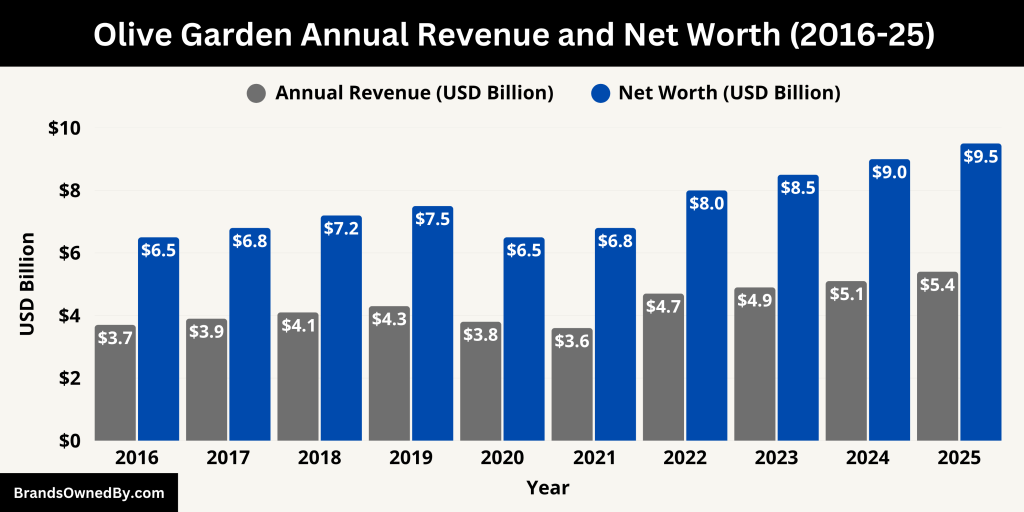Olive Garden is one of the most popular Italian-American restaurant chains in the United States. Known for its pasta, breadsticks, and family-style meals, many people often wonder: who owns Olive Garden today? Let’s explore the ownership structure, company background, financials, and leadership of this iconic brand.
Olive Garden Company Profile
Olive Garden is a popular American casual dining restaurant chain specializing in Italian-American cuisine. Known for its pasta dishes, unlimited breadsticks, and family-friendly environment, Olive Garden has become a household name in the United States and select international markets.
Company Details
- Brand Name: Olive Garden
- Parent Company: Darden Restaurants, Inc.
- Headquarters: Orlando, Florida, USA
- Industry: Casual Dining / Restaurant
- Cuisine Style: Italian-American
- Type of Ownership: Subsidiary of publicly traded company (Darden)
- Locations: Over 900 restaurants as of 2025.
Olive Garden is Darden’s largest and most profitable brand, contributing nearly half of the company’s overall revenue. The brand positions itself between fast-casual and fine dining, offering affordable meals with generous portions and a casual dining experience.
Olive Garden Founders
Olive Garden was founded by General Mills, Inc.—the same company known for its cereals and packaged foods. The brand was not created by a single entrepreneur but developed in-house by General Mills’ restaurant division to compete in the growing Italian dining segment.
The first Olive Garden opened in Orlando, Florida, in 1982. The concept quickly gained popularity for its accessible Italian-style food and casual, family-friendly service model.
Major Milestones
- 1982: The first Olive Garden restaurant opened in Orlando, Florida.
- 1989: Olive Garden became the fastest-growing unit in General Mills’ restaurant division, opening nearly 145 locations within seven years.
- 1995: General Mills spun off its restaurant operations into a new entity, Darden Restaurants, Inc. Olive Garden became a key part of Darden’s portfolio.
- 1999: Olive Garden began remodeling its stores and menu, moving toward a more authentic Tuscan theme.
- 2009: Darden introduced a “Culinary Institute of Tuscany” training program to give chefs a deeper understanding of Italian cuisine, enhancing brand authenticity.
- 2014: Olive Garden launched its “Never Ending Pasta Pass,” a marketing campaign that went viral and boosted brand visibility.
- 2017–2020: Olive Garden modernized its menu and added online ordering, curbside pickup, and delivery to stay competitive with fast-casual chains.
- 2020–2022: During the COVID-19 pandemic, Olive Garden adapted with increased investment in digital platforms and takeout operations.
- 2023–2025: Olive Garden continued to expand in suburban markets and announced international partnerships in Latin America and the Middle East.
Who Owns Olive Garden in 2025?
Olive Garden is not independently owned. It is a wholly owned brand operated under Darden Restaurants, Inc., a major American multi-brand restaurant operator. As a subsidiary, Olive Garden does not have its own stock or ownership structure—it is directly managed and financed by its parent company.
Parent Company: Darden Restaurants, Inc.

Darden Restaurants, Inc. is the official parent company of Olive Garden. It owns and operates a portfolio of full-service restaurant brands in the United States. Darden is a publicly traded company listed on the New York Stock Exchange under the ticker symbol DRI.
Darden was formed in 1995 when General Mills spun off its restaurant division, which included Olive Garden and Red Lobster. Since then, Darden has expanded its restaurant portfolio through new brand development and acquisitions.
As of 2025, Darden manages over 1,900 restaurants across North America, with Olive Garden being its largest brand by revenue and number of locations. Darden handles all corporate-level decisions for Olive Garden including marketing, finance, real estate, human resources, and menu development.
Ownership Structure
Since Darden is a publicly traded company, it is owned by a mix of institutional investors, mutual funds, pension funds, and retail shareholders. The ownership of Olive Garden flows through these shareholders who hold stakes in Darden.
There is no individual or private group that owns Olive Garden directly. The company’s board of directors and executive team oversee decision-making and appoint brand-level leaders to manage operations.
The largest shareholders of Darden include:
- The Vanguard Group Inc.
- BlackRock Inc.
- State Street Global Advisors
- Various mutual fund companies, retirement plans, and ETFs.
Olive Garden was created internally by General Mills in 1982 as part of its strategy to enter the casual dining market. The concept was developed to complement General Mills’ existing restaurant portfolio, which included Red Lobster.
When General Mills spun off its restaurant division in 1995, Olive Garden became part of Darden Restaurants, which has remained its parent company ever since.
Other Relevant Details
- Olive Garden is fully operated by Darden, with no franchisees in the U.S. Most of its domestic locations are company-owned. However, a limited number of international Olive Garden restaurants operate under licensing agreements.
- The brand leadership is integrated into Darden’s executive structure. A brand president or senior vice president is responsible for Olive Garden’s specific operations, reporting directly to Darden’s CEO.
- Olive Garden’s continued growth and profitability are central to Darden’s overall strategy. It often receives the largest share of capital investment among Darden brands, especially in areas such as remodeling, digital ordering, and kitchen upgrades.
- Any strategic changes, such as introducing new menu items or expanding delivery services, are made at the corporate level by Darden, not independently by Olive Garden.
Who is the CEO of Olive Garden?
Since Olive Garden is a brand under Darden Restaurants, its operations fall under the leadership of Darden’s CEO. The current CEO is Ricardo “Rick” Cardenas, who oversees Olive Garden along with Darden’s other brands.
Background & Career Path
Rick Cardenas started with Darden in 1984 as a busser at a Red Lobster restaurant. This early role ignited his passion for the restaurant industry. After earning degrees in finance and accounting from the University of Central Florida and an MBA from Dartmouth’s Tuck School, he returned to Darden in 2001. Since then, he advanced through key roles in finance, strategy, and operations across major Darden brands.
CEO Appointment
In December 2021, the Darden board unanimously elected Cardenas to succeed Eugene “Gene” Lee Jr. as CEO, with his term officially beginning on May 30, 2022. He is the fourth CEO in Darden’s history.
Leadership Responsibilities
As CEO, Rick Cardenas oversees the performance and strategy of all Darden brands. This includes Olive Garden, LongHorn Steakhouse, The Capital Grille, Yard House, Cheddar’s, Eddie V’s, and more. He directs corporate initiatives on menu innovation, digital strategy, and capital allocation. He also led Darden’s decision to divest or reposition underperforming brands such as Bahama Breeze.
Leadership Style & Achievements
- Operational Excellence: Cardenas emphasizes “brilliant basics” and value-focused offerings, which drove significant same-restaurant sales growth—6.9% at Olive Garden in the most recent quarter.
- Strategic Acquisitions: Under his leadership, Darden acquired Chuy’s Tex-Mex chain in a $605 million deal, extending the company’s reach into new cuisine segments.
- Financial Performance: He guided Darden through a recent quarter reporting total sales of $3.27 billion and earnings of $2.98 per share—both exceeding expectations.
Compensation & Share Ownership
Carenas’s compensation reflects performance alignment. His base salary is $1 million, with bonus potential at 150% of that amount and significant equity grants. He also engages in insider trading; in March 2025, he sold over 20,000 Darden shares valued at approximately $4.27 million.
Predecessors
- Eugene I. “Gene” Lee Jr. served as CEO from 2015 until his retirement in May 2022. Under his tenure, Darden’s market cap tripled and revenue rose by over $2 billion.
- Clarence Otis Jr. preceded Lee and guided the company during its early post-spinoff years.
- William Darden founded the predecessor of Darden Restaurants through Red Lobster. The formal Darden company emerged in 1995.
Olive Garden Annual Revenue and Net Worth

In fiscal year 2025, Olive Garden generated an estimated $5.4 billion in total revenue. This marks a growth of over 5% compared to its fiscal 2024 revenue, which was approximately $5.1 billion.
This increase is attributed to:
- Higher same-restaurant sales (+6.9%)
- Continued customer traffic recovery
- Expanded use of digital ordering, curbside pickup, and third-party delivery partnerships
- Steady store count growth, with over 900 locations operating in the U.S. and select international markets.
Olive Garden remains the largest revenue contributor within the Darden portfolio, accounting for roughly 45%–47% of the parent company’s total revenue.
Here’s a summary of the key financial metrics:
| Metric | Value (2025) |
|---|---|
| Annual Revenue | $5.4 billion |
| Net Worth / Brand Valuation | $8.5–$9.5 billion (estimated) |
| Total Restaurant Locations | 900+ |
| Revenue Growth (YoY) | 5%+ |
Olive Garden Net Worth / Brand Valuation
Olive Garden, while not publicly listed or independently valued on the stock exchange, holds substantial brand equity within the restaurant industry. As of 2025, financial analysts and brand valuation experts estimate the net worth or brand value of Olive Garden to be between $8.5 billion and $9.5 billion in June 2025.
This estimated valuation is based on:
- The brand’s annual revenue
- Its operating income margin (which averages 18–20%)
- Long-term customer loyalty and strong market position
- Consistent profitability and cash flow performance
- Its ability to support the dividends and stock performance of its parent company
While the brand doesn’t release a separate balance sheet, Olive Garden’s contribution to Darden’s earnings per share and return on capital makes it one of the most valuable casual dining chains in North America.
Here is a detailed overview of the historical revenue and brand valuation (net worth) of Olive Garden over the last 10 years (2016–2025):
| Fiscal Year | Estimated Annual Revenue | Estimated Net Worth (Brand Value) |
|---|---|---|
| 2025 | $5.4 billion | $8.5–9.5 billion |
| 2024 | $5.1 billion | $8.0–9.0 billion |
| 2023 | $4.9 billion | $7.5–8.5 billion |
| 2022 | $4.7 billion | $7.0–8.0 billion |
| 2021 | $3.6 billion | $6.0–6.8 billion |
| 2020 | $3.8 billion | $5.8–6.5 billion |
| 2019 | $4.3 billion | $6.8–7.5 billion |
| 2018 | $4.1 billion | $6.5–7.2 billion |
| 2017 | $3.9 billion | $6.0–6.8 billion |
| 2016 | $3.7 billion | $5.5–6.5 billion |
Brands Owned by Olive Garden
As of 2025, Olive Garden manages and oversees a number of internal entities and service models under the Olive Garden brand. These do not qualify as separate companies but represent sub-brands, licensed international branches, and strategic service extensions that function under the Olive Garden umbrella.
Below is a breakdown of the major brands owned by Olive Garden:
| Name | Type | Ownership | Description | Revenue Contribution | Notes |
|---|---|---|---|---|---|
| Olive Garden U.S. Restaurants | Company-operated chain | 100% Olive Garden | Core dine-in business with 900+ restaurants across the U.S. | ~80% | Largest and primary source of revenue |
| Olive Garden To Go | Service division | Operated by Olive Garden | Online ordering, delivery, and curbside pickup for takeout services | ~10–12% | Gained traction post-2020; available nationwide |
| Olive Garden International | Licensed operations | Brand licensed abroad | Locations in Latin America, Middle East, and Caribbean through licensees | ~5% | Royalty and licensing revenue only |
| Olive Garden Catering | Service extension | Operated by Olive Garden | Catering for corporate events, parties, schools, and institutions | ~3–5% | Offered in most major cities |
| Olive Garden Retail Products | Brand licensing | Name licensed to partners | Packaged salad dressings, sauces, and croutons sold in grocery stores | <1% | Managed under licensing partnerships |
Olive Garden U.S. Restaurants
This is the core domestic operation of Olive Garden, with over 900 locations across the United States as of 2025. These restaurants are company-owned, not franchised, and represent the largest share of Olive Garden’s annual revenue. U.S. locations feature the full dining menu, lunch and dinner service, and are supported by regional corporate teams that report back to Darden leadership.
Olive Garden To Go
Launched in phases between 2017 and 2020, Olive Garden To Go has become a strategic service model targeting the takeout and delivery market. By 2025, To Go generates a significant portion of Olive Garden’s sales, especially in urban and suburban areas. The platform includes:
- Online ordering through Olive Garden’s official app and website
- Curbside pickup service at most locations
- Integration with third-party delivery services (like Uber Direct)
While not a standalone brand, Olive Garden To Go is managed as a separate vertical within the Olive Garden system and operates under specific revenue and performance metrics.
Olive Garden International (Licensed Operations)
Although Olive Garden does not franchise in the U.S., it licenses its brand internationally through exclusive agreements. These international Olive Garden restaurants are operated by foreign licensees but use Olive Garden branding, menus (with regional adaptations), and corporate training systems.
Active licensed markets as of 2025 include:
- Mexico
- Kuwait
- Panama
- UAE
- Brazil
- Puerto Rico (considered international for licensing purposes)
These locations are not independently owned by Olive Garden, but Olive Garden controls the intellectual property and enforces brand standards. It receives licensing fees and brand royalties from international operators.
Olive Garden Catering Services
Olive Garden offers large-format meals and customizable catering menus under a branded catering division. This unit focuses on:
- Family-sized meal trays
- Business lunch packages
- Event-based offerings for schools, offices, and local organizations
By 2025, Olive Garden Catering contributes a growing share of revenue, particularly in metro areas. It is not a distinct brand or legal entity but functions as a specialized extension of the Olive Garden business model.
Olive Garden Retail Products (Limited Release)
Although not widely available, Olive Garden has in recent years launched retail food products such as salad dressings, pasta sauces, and croutons through partnered manufacturers. These products are sold in supermarkets under the Olive Garden brand. They are part of a co-branded retail strategy, where Olive Garden licenses its name but does not own the production or distribution.
This venture remains limited but supports brand recognition and opens a secondary revenue stream through licensing and royalties.
Final Thoughts
Olive Garden is not an independent company but a key part of Darden Restaurants. It is owned by a wide network of institutional and retail shareholders. The brand’s continued success is driven by strong leadership, a loyal customer base, and a diversified restaurant portfolio under Darden. Understanding who owns Olive Garden helps shed light on how major restaurant chains operate in today’s market.
FAQs
Who is Olive Garden owned by?
Olive Garden is owned by Darden Restaurants, Inc., a publicly traded American restaurant group. Darden fully operates and controls the Olive Garden brand and its business.
Does General Mills still own Olive Garden?
No, General Mills no longer owns Olive Garden. General Mills created Olive Garden in 1982 but spun off its restaurant division in 1995, forming Darden Restaurants as an independent company. Since then, Darden has been the sole owner.
Are Olive Garden and Red Lobster owned by the same company?
Not anymore. Olive Garden and Red Lobster were once sister brands under both General Mills and then Darden Restaurants. However, Darden sold Red Lobster in 2014. As of 2025, Olive Garden is still with Darden, while Red Lobster is owned by a separate investment group.
Is Olive Garden a franchise?
In the United States, Olive Garden is not a franchise. All U.S. locations are company-owned and operated by Darden. However, some international Olive Garden restaurants are licensed, not franchised, to local partners under strict brand guidelines.
Who owns Olive Garden Darden?
Darden Restaurants owns Olive Garden. Darden itself is owned by public shareholders and traded on the New York Stock Exchange under the symbol DRI. Its largest shareholders include institutional investors like Vanguard and BlackRock.
Is the first Olive Garden still open?
No, the original Olive Garden location, which opened in Orlando, Florida in 1982, is no longer in operation. It was eventually closed as newer and updated locations opened across the country.
Is Olive Garden owned by Darden Restaurants?
Yes, Olive Garden is 100% owned and operated by Darden Restaurants. It is the largest and most profitable brand in Darden’s portfolio.
When did Olive Garden become a restaurant?
Olive Garden opened its first restaurant in 1982 in Orlando, Florida. It was developed by General Mills to tap into the growing popularity of Italian-American dining in the U.S.
Who founded Olive Garden?
Olive Garden was founded by General Mills, Inc., not an individual entrepreneur. It was created as part of the company’s strategy to expand into the casual dining restaurant sector.
Who is the parent company of Olive Garden?
Darden Restaurants, Inc. is the parent company that owns and operates Olive Garden.
Is Olive Garden privately owned?
No, Olive Garden is owned by a public company, Darden, which is traded on the NYSE under the symbol DRI.
What is Olive Garden’s annual revenue?
In 2025, Olive Garden generated around $5.4 billion in revenue.
How many locations does Olive Garden have?
As of 2025, Olive Garden operates over 900 restaurants across the U.S. and select international markets.

